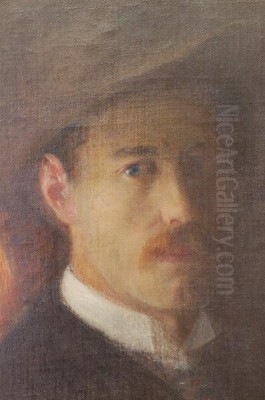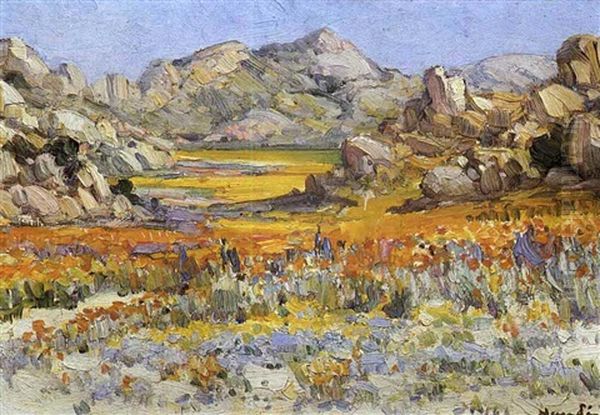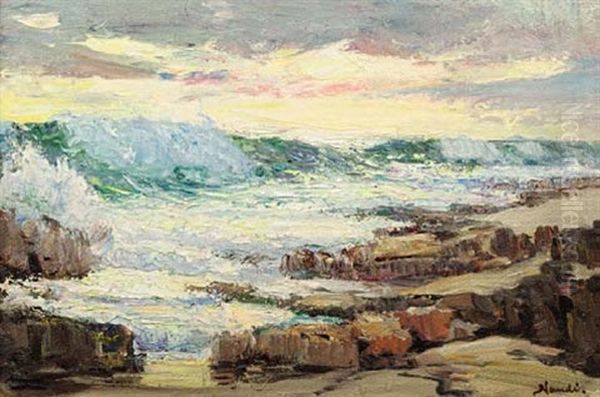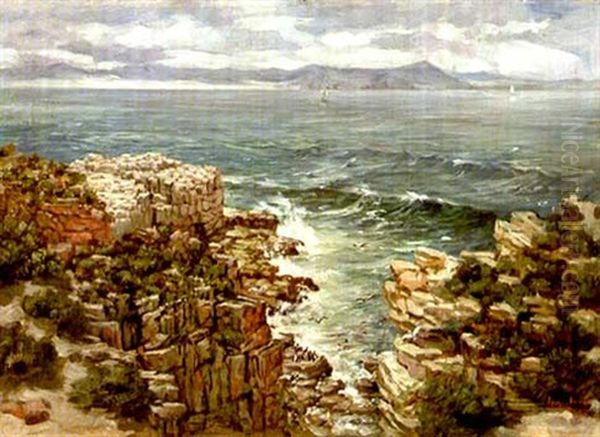
Pieter Hugo Naudé stands as a seminal figure in the history of South African art. Born during a period of transition and burgeoning national consciousness, he became one of the very first South African-born artists to seek formal art training in Europe. His life and work bridge the gap between European academic traditions and the unique light, landscape, and spirit of his homeland. Naudé's dedication to capturing the essence of the South African veld, mountains, and coastal regions established him as a foundational landscape painter and earned him enduring recognition. His journey reflects not only a personal artistic quest but also the broader story of South African art finding its own voice.
Early Life and Formative Influences
Pieter Hugo Naudé was born in 1869 in the Worcester district of the Cape Colony, on a farm named 'Aan-de-Doorns'. His connection to the rural landscape was established from his earliest days. His mother's family name was Hugo, which led to him often being referred to as Hugo Naudé. His initial education took place locally in Worcester and the nearby Over Hex region. Even in these formative years, his artistic inclinations began to surface, drawing inspiration from the dramatic scenery of the Breede River Valley.
A pivotal moment in his youth came through the encouragement of the noted author and feminist thinker, Olive Schreiner. Schreiner, known for her novel The Story of an African Farm, recognized Naudé's burgeoning talent and urged him to pursue formal art training abroad. This encouragement was bolstered by a recommendation from the writer and social reformer Havelock Ellis, who further validated Naudé's potential. Supported by such influential figures, the young Naudé embarked on a journey to Europe in 1889, a step that would profoundly shape his artistic trajectory and, consequently, the course of South African art.
European Training: London, Munich, and Fontainebleau

Naudé's European sojourn began in London, where he enrolled at the prestigious Slade School of Fine Art. From 1890 to 1894, he immersed himself in the rigorous academic training offered by the Slade. During this period, the school was a hub of artistic innovation, moving away from rigid Victorian conventions. Instructors like Henry Tonks and Philip Wilson Steer were championing draughtsmanship and a more direct engagement with the subject, often influenced by French Impressionism and Post-Impressionism. Naudé would have absorbed these influences, honing his technical skills while being exposed to contemporary European art movements.
Following his time in London, Naudé sought further refinement in Germany, studying at the Kunstakademie in Munich from 1894 to 1895. Munich was another major art centre, known for its strong academic tradition but also for the burgeoning Secession movement, which challenged established norms. Artists like Franz von Lenbach, known for his society portraits, were prominent figures, though younger artists associated with the Secession, such as Lovis Corinth and Max Slevogt, were pushing towards bolder, more expressive styles. Naudé's exposure to the Munich school likely reinforced his technical grounding while potentially introducing him to different approaches to realism and painterly techniques.
A significant part of his European education involved time spent in France, particularly near Fontainebleau. He worked among the artists associated with the Barbizon School. This group, including painters like Jean-Baptiste-Camille Corot, Jean-François Millet, and Théodore Rousseau, emphasized painting directly from nature (en plein air) and sought to capture the moods and atmospheres of the landscape with truthfulness. The Barbizon focus on light, tonal harmony, and the depiction of rural life resonated deeply with Naudé and would become central tenets of his own artistic practice upon his return to South Africa. He also spent a brief period working in Italy before concluding his European studies.
Return to South Africa and Artistic Maturity
In 1896, Pieter Hugo Naudé returned to his native South Africa, equipped with extensive European training but with a vision increasingly focused on his homeland. He initially settled back on the family farm, 'Aan-de-Doorns', using the familiar landscapes of the Worcester district as his primary subject matter. The transition involved adapting the techniques learned in the softer light of Europe to the harsh, bright sunlight and dramatic colours of the South African veld. This period was crucial for developing his distinctive style, one that blended European influences with a deeply personal response to the local environment.

Recognizing the need for a dedicated space to pursue his art, Naudé moved into the town of Worcester in 1904. There, he designed and built his own house and studio, a space that would become a hub for his artistic activities for the rest of his life. This move signified his commitment to a professional artistic career within South Africa. The studio provided him with the stability and environment needed to produce larger works and further refine his approach to capturing the diverse landscapes of the Cape.
From his base in Worcester, Naudé continued to explore the surrounding regions. Between 1905 and 1918, he undertook numerous expeditions, often venturing into remote areas of the Worcester district and beyond. These trips were essential for gathering sketches and immersing himself in the landscapes he sought to portray. His dedication to firsthand observation, a principle likely reinforced by his Barbizon experience, remained a cornerstone of his practice throughout his career.
A Distinctive South African Impressionism
Pieter Hugo Naudé's artistic style is often characterized as a form of South African Impressionism. While clearly influenced by European Impressionism and the Barbizon School, particularly in his attention to light, colour, and atmospheric effects, his work possesses a unique quality rooted in the specific conditions of the South African landscape. He masterfully captured the intense clarity of light, the vibrant, sometimes harsh colours of the veld, and the dramatic forms of the mountains and coastlines.
His technique involved applying paint with visible brushstrokes, often building up textures to convey the ruggedness of the terrain or the ephemeral quality of light. Unlike some European Impressionists who dissolved form in light, Naudé generally maintained a strong sense of structure and draughtsmanship in his compositions, perhaps reflecting his Slade training. He was particularly adept at depicting the changing seasons, from the arid tones of the Karoo summer to the spectacular bursts of colour during the Namaqualand spring flower season.
Key representative works exemplify his style. Paintings like Namaqualand Daisies showcase his ability to handle vibrant colour on a large scale, capturing the almost unbelievable spectacle of the desert in bloom. Brandvley, Worcester demonstrates his skill in rendering the specific light and atmosphere of the Breede River Valley, a region he knew intimately. Coastal scenes, such as Springtide at Hermanus and View of Hermanus Bay, reveal his sensitivity to the interplay of sea, sky, and land along the Cape coast. These works are celebrated for their authenticity and their ability to convey a palpable sense of place.
The Traveling Artist: Documenting the Land

A remarkable aspect of Pieter Hugo Naudé's career was his commitment to extensive travel throughout Southern Africa, often under challenging conditions. He commissioned a specially designed vehicle – essentially an early motor caravan built on a Chevrolet truck chassis – which served as a mobile studio and living quarters. This allowed him to venture far beyond easily accessible areas, reaching remote parts of the country to paint directly from nature.
His journeys took him through the arid landscapes of Namaqualand, famous for its spring flowers, the rugged terrain of the Karoo, the majestic Drakensberg mountains, and even as far north as Victoria Falls in present-day Zimbabwe. These expeditions were not mere sightseeing trips; they were intensive periods of artistic production. He would spend weeks or months on the road, sketching and painting en plein air, absorbing the unique character of each region.
During these travels, Naudé produced a vast number of oil sketches, drawings, and finished paintings. He was also proficient in silverpoint, a demanding drawing technique using a silver stylus on prepared paper, which produces fine, delicate lines. His silverpoint drawings, often capturing subtle details of landscapes or botanical subjects, demonstrate his exceptional draughtsmanship. This dedication to traveling and documenting diverse landscapes significantly broadened the scope of South African landscape painting, presenting views of the country that were previously unfamiliar to many urban audiences. His mobile studio itself became something of a legend, symbolizing his adventurous spirit and dedication to his craft.
Themes, Subjects, and Social Context
While primarily celebrated as a landscape painter, Pieter Hugo Naudé's oeuvre encompassed other subjects as well. He was an accomplished portraitist, capturing the likenesses of various individuals within his community and beyond. These portraits often display a sensitivity and psychological insight that complements his landscape work.
Furthermore, Naudé occasionally produced genre scenes depicting aspects of rural and domestic life in the Cape. A notable example is Cape Kitchen Interior. This work offers a glimpse into the social dynamics of the time, depicting figures from different racial and social backgrounds within a domestic setting. Such works provide valuable historical insights and demonstrate Naudé's awareness of the social fabric of his society, moving beyond purely aesthetic concerns to touch upon the human condition within the South African context.

His deep connection to the land, however, remained the dominant theme. His landscapes were more than just topographical records; they often conveyed a profound sense of belonging and a celebration of the natural beauty of South Africa. In an era when the country was forging its identity, Naudé's work contributed to a growing appreciation for the local environment, helping to shape a visual language for South African identity rooted in its unique landscapes. His paintings resonated with a public increasingly interested in depictions of their own country, distinct from European scenes.
Professional Recognition and Affiliations
Pieter Hugo Naudé achieved significant recognition during his lifetime, both within South Africa and internationally. He was a founding member or early participant in key artistic organizations that aimed to promote South African art. In 1902, he joined the South African Society of Artists (SASA), a crucial body for exhibiting and fostering local talent. His involvement with such groups helped to professionalize the art scene in the Cape. Some sources also mention his association with 'The Baakens' art group, possibly serving as its chair in 1906, indicating his active role in the artistic community.
His work was regularly included in major South African exhibitions and also shown overseas. Exhibitions in London and Paris brought his depictions of the South African landscape to international audiences, contributing to a growing awareness of art from the region. His distinct style and authentic portrayal of his homeland garnered positive critical attention.
Formal accolades followed. In 1938 (some sources cite 1935), he was awarded the prestigious Medal of Honour for Painting by the Suid-Afrikaanse Akademie vir Wetenskap en Kuns (South African Academy for Science and Arts), a significant acknowledgment of his contribution to national culture. Another notable commission came in 1936 when he designed a rock garden for the Empire Exhibition held in Johannesburg, showcasing his versatility beyond easel painting. Today, his works are held in major public collections across South Africa, including the Iziko South African National Gallery in Cape Town, the Pretoria Art Museum, and the Ditsong National Museum of Cultural History in Pretoria, cementing his place in the national artistic heritage.
Relationships, Influence, and Contemporaries
Pieter Hugo Naudé did not work in isolation. He interacted with and influenced other artists, contributing to the development of a South African artistic tradition. One notable relationship was with the younger artist Piet van Heerden (1917-1991). Van Heerden lived and worked with Naudé in his Worcester home during the final years of Naudé's life, from 1939 to 1941. While van Heerden developed his own naturalistic style, the influence of Naudé, alongside that of another significant early Cape painter, Pieter Wenning (1873-1921), is evident in his work.
Naudé is often considered alongside other pioneers of South African art who were active during the late 19th and early 20th centuries. Jan Volschenk (1853-1936), another artist dedicated to the landscapes of the Cape, particularly the Langeberg mountains, is frequently mentioned in conjunction with Naudé. Together, they helped establish landscape painting as a major genre in South African art. Anton van Wouw (1862-1945), primarily a sculptor known for his bronze figures, was another contemporary who contributed significantly to the burgeoning national art scene. Frans Oerder (1867-1944), who arrived from the Netherlands and also embraced South African subjects with an Impressionistic touch, was another important figure of the era.
While Naudé's training connected him to European traditions (including the indirect influence of figures like Franz von Lenbach through the Munich school, or the Barbizon painters like Corot and Millet), his primary significance lies in his adaptation of these influences to a local context. He paved the way for subsequent generations of South African artists. Although later modernists like Maggie Laubser (1886-1973) and Irma Stern (1894-1966) would introduce more radical, Expressionist styles, and J. H. Pierneef (1886-1957) would develop a highly stylized and iconic approach to landscape, Naudé's foundational work in capturing the light and spirit of the South African scene remained influential.
Legacy and Art Historical Significance
Pieter Hugo Naudé's legacy in South African art history is substantial and multifaceted. As one of the first locally-born artists to receive extensive formal training in Europe and return to dedicate his career to depicting his homeland, he played a crucial pioneering role. He effectively translated European techniques, particularly those related to Impressionism and plein air painting, to suit the unique environmental conditions of South Africa, creating a style that was both informed by international trends and authentically local.
His unwavering focus on the South African landscape helped to elevate it as a worthy subject for serious art, fostering a national appreciation for the country's natural beauty. His adventurous spirit, exemplified by his travels in his custom-built mobile studio, allowed him to document a wide range of terrains and atmospheres, broadening the visual representation of the nation. His work provided a touchstone for subsequent landscape painters and contributed significantly to the formation of a South African school of painting.
Upon his death in 1941, the community of Worcester recognized his importance by purchasing his house and studio, which later became the Hugo Naudé Art Centre. This institution continues to serve as a cultural hub for the town and region, honouring his memory and promoting the arts. While some critics might note that his style, though accomplished, did not represent a radical break from established European conventions in the way that later modernists achieved, his achievement lies in his successful adaptation and popularization of these styles within a South African context. He made the familiar landscapes of his country visible and artistically significant, earning him an enduring place as a beloved and foundational figure in South African art.
Conclusion
Pieter Hugo Naudé remains a cornerstone figure in the narrative of South African art. His life journey, from a farm in the Worcester district to the art academies of Europe and back to the expansive landscapes of his homeland, encapsulates a pivotal moment in the development of a distinct national artistic identity. Through his dedication, skill, and adventurous spirit, he captured the unique light, colour, and atmosphere of South Africa with unprecedented sensitivity. His prolific output, particularly his landscape paintings, not only earned him contemporary acclaim but also laid essential groundwork for future generations of artists. Works like Namaqualand Daisies and his many depictions of the Cape's mountains and coasts continue to resonate, celebrating the beauty of the land and securing Naudé's legacy as a true pioneer of South African painting.